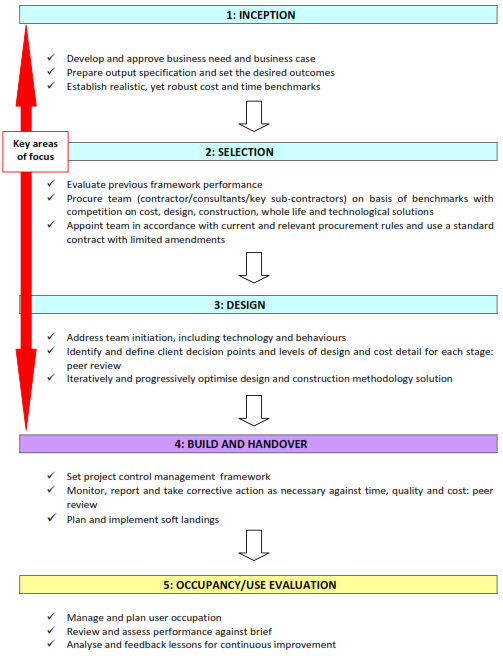Cost led procurement
Contents |
[edit] Introduction
The main aims of the Government Construction Strategy were to ‘change the relationship between Clients and Industry’ and achieve a 15-20% reduction in public sector construction costs by 2015. The Government Construction Task Group report 2012 developed three potential new strategies to help achieve these aims:
- Cost Led Procurement (CLP).
- Integrated Project Insurance (IPI).
- Two Stage Open Book.
All three involve early contractor involvement, transparency and integration. Along with a reduction in costs, they are expected to contribute to a reduction in project risk, improved programme accuracy and an enhanced working relationship between client and the supply chain.
[edit] Background
The Cost Led Procurement method is ‘...intended to allow industry to use its experience and knowledge to develop innovative solutions through leveraging design, materials, subcontracting, direct labour and experience to the advantage of the Public Sector Client...focused on achieving target costs whilst maintaining, if not improving value’ (Cabinet Office, 2014).
In Cost Led Procurement, the project details are clearly identified and a ceiling cost calculated. Typically, an integrated supply team (one or more) is identified through a framework agreement and the team work together to complete the project at below the ceiling cost. In subsequent similar projects within a framework, Cost Led Procurement offers the opportunity for further reduction of costs.
The project is offered to suppliers outside the framework if none of the existing teams are able to deliver the project below the ceiling cost.
[edit] Structure
The CLP plan involves five phases:
- Inception.
- Selection of contractor.
- Design and cost development.
- Construction.
- Operation
The flow chart from the 2014 Cabinet Office publication, Cost Led Procurement Guidance outlines the process.
[edit] Trial projects
Two trial projects were run using the CLP method: Upper Mole and Rye Harbour. The Rye Harbour scheme was successful in achieving a 6% saving through reducing the project programme.
This article contains public sector information licensed under the Open Government Licence v2.0 ref Cabinet Office, Cost Led Procurement Guidance 2014.
[edit] Related articles on Designing Buildings Wiki
- Framework agreement.
- Government construction strategy.
- Integrated project insurance.
- Integrated supply team.
- Managing the procurement process.
- Optimised contractor involvement.
- Procurement route.
- Supply chain.
- Supply chain management.
- Sustainable procurement.
- The benefits of e-procurement in construction.
- Two stage open book.
- Value for money.
[edit] External references
Featured articles and news
The UK's Modern Industrial Strategy: A 10 year plan
Previous consultation criticism, current key elements and general support with some persisting reservations.
Building Safety Regulator reforms
New roles, new staff and a new fast track service pave the way for a single construction regulator.
Architectural Technologist CPDs and Communications
CIAT CPD… and how you can do it!
Cooling centres and cool spaces
Managing extreme heat in cities by directing the public to places for heat stress relief and water sources.
Winter gardens: A brief history and warm variations
Extending the season with glass in different forms and terms.
Restoring Great Yarmouth's Winter Gardens
Transforming one of the least sustainable constructions imaginable.
Construction Skills Mission Board launch sector drive
Newly formed government and industry collaboration set strategy for recruiting an additional 100,000 construction workers a year.
New Architects Code comes into effect in September 2025
ARB Architects Code of Conduct and Practice available with ongoing consultation regarding guidance.
Welsh Skills Body (Medr) launches ambitious plan
The new skills body brings together funding and regulation of tertiary education and research for the devolved nation.
Paul Gandy FCIOB announced as next CIOB President
Former Tilbury Douglas CEO takes helm.
UK Infrastructure: A 10 Year Strategy. In brief with reactions
With the National Infrastructure and Service Transformation Authority (NISTA).
Ebenezer Howard: inventor of the garden city. Book review.
The Grenfell Tower fire, eight years on
A time to pause and reflect as Dubai tower block fire reported just before anniversary.
Airtightness Topic Guide BSRIA TG 27/2025
Explaining the basics of airtightness, what it is, why it's important, when it's required and how it's carried out.
Construction contract awards hit lowest point of 2025
Plummeting for second consecutive month, intensifying concerns for housing and infrastructure goals.
Understanding Mental Health in the Built Environment 2025
Examining the state of mental health in construction, shedding light on levels of stress, anxiety and depression.






















